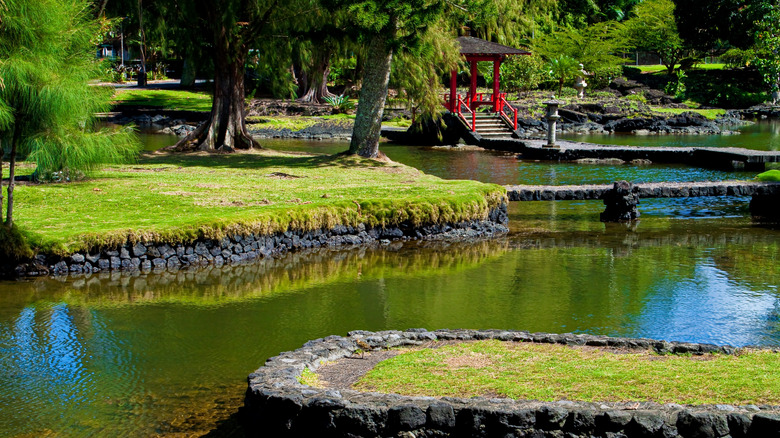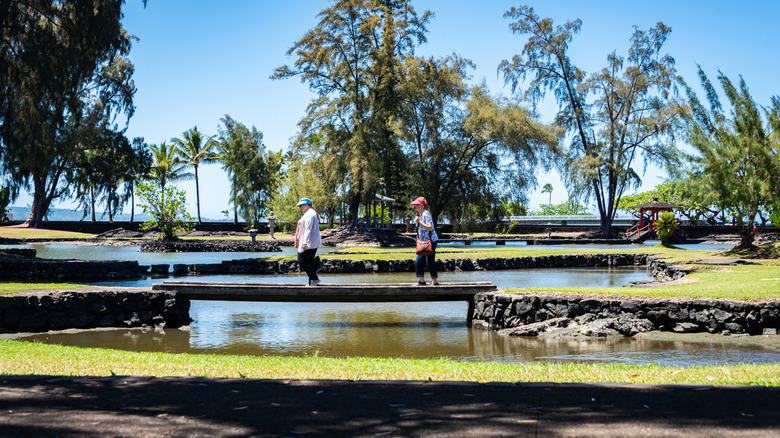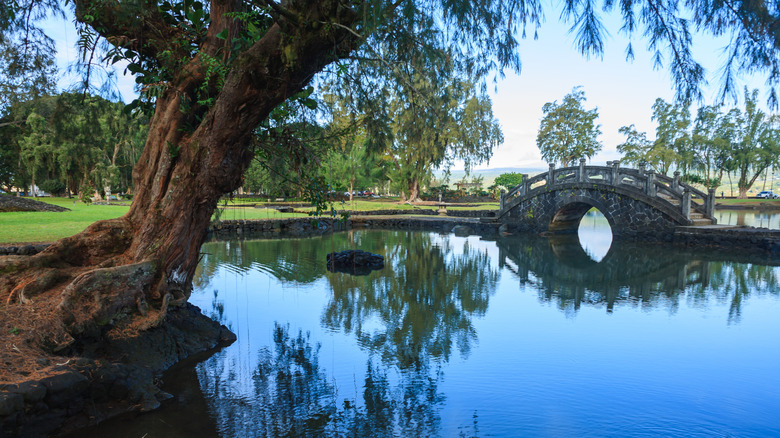The Heart Of Hilo Boasts The Most Picturesque Authentic Japanese Garden Outside Of Japan
We may receive a commission on purchases made from links.
Suppose you wake up in Liliuokalani Gardens, and you can't remember how you got there. You stand up, look around, and see a stone bridge, a bright red pavilion, and carefully crafted waterways. Paths cut through grassy lawns. Diverse trees are evenly spaced across the grounds. The place is beautiful, peaceful, and –– because of this strange case of amnesia –– you'd swear you've just woken up in Japan.
But the Liliuokalani Gardens aren't in Japan; they're located in Hilo, the largest city and capital of the Big Island of Hawaii. The manicured estate is closely modeled on the Japanese gardens of the Edo Period, the two-and-a-half-century renaissance in Japanese culture. Not only is Liliuokalani based on the distinctive Edo architecture and layout, but it's also the largest and most authentic garden of its type outside of Japan. Many gardens in the United States have taken their inspiration from the Land of the Rising Sun — like the Japanese Tea Garden in San Antonio, Texas — but Liliuokalani is by far the most convincing homage.
The gardens are free to enter and open all day and night, and they are featured regularly on tours of Hilo and its environs. One standout tour is the Hawaii Volcanoes National Park and Hilo Highlights Small Group Tour on Viator. This 5.5-hour excursion hits the hotspots in this storied Hawaiian community, helping newcomers appreciate all the qualities that make the Big Island so special.
A tour that shows all the beautiful sights of Hilo
The Viator tour arranges hotel or cruise ship pickup, so you'll hit the ground running. First, you'll head to Hawaii Volcanoes National Park (located nearby), where you're likely to get a chance to stand face-to-face with glowing magma and sulfuric clouds. Next, enter the Thurston Lava Tube (also known as Nahuku), a 500-year-old cave basalt corridor that burrows into the ground. After that, take photos in front of the picture-perfect Rainbow Falls. Since this tour is a smaller group, it will make it easier to take photos in front of this tropical cascade.
At last, the Viator tour arrives at Liliuokalani Gardens, where you can spend your final 20 minutes in zen tranquility. Liliuokalani Gardens is located just north of downtown Hilo and is cater-cornered to Hilo International Airport, so it's an easy place to return to if you'd like more time. Altogether, these sights are just some of the highlights of the greater Hilo area as well as some of the reasons why you should visit the stunning and underrated Big Island of Hawaii. As past participants in the tour have remarked, "From the very first moment, we were made very welcome by our tour guide Jill who was extremely [knowledgeable] about both the scientific and cultural elements of our Volcano Tour." Another participant said, "Josh was very entertaining and knowledgeable. He shared a lot of local stories and history. He made several stops in the park to ensure we had a total experience."
Over 100 years of serenity at the Liliuokalani Gardens in Hilo
As pretty much every Hawaiian is aware, Queen Liliuokalani (who the gardens are named after) was a famed Indigenous monarch, the last to rule the Kingdom of Hawaii. The park exists because the queen donated five acres on the Waiakea peninsula for its development, a parcel that would eventually expand to 17 acres. The garden opened in 1919, two years after her passing. You could easily add this site to a list of Hawaiian hidden gems that only locals know.
Why a Japanese garden, though? How did this come to be? The first Japanese immigrants arrived in Hawaii in 1885, where they would mostly work in sugar cane cultivation. By the turn of the century, the Japanese community on the Big Island was large enough to support a women's society, known as Hilo Shinkokai. As it happened, a well-heeled local woman named Laura Vestal Kennedy had spent time in Japan and fostered a passion for Edo-style gardens. As of present, about 14 percent of Hawaiian residents can claim Japanese ancestry and the garden honors that heritage. Plus, it's just beautiful and serene to stroll through.


